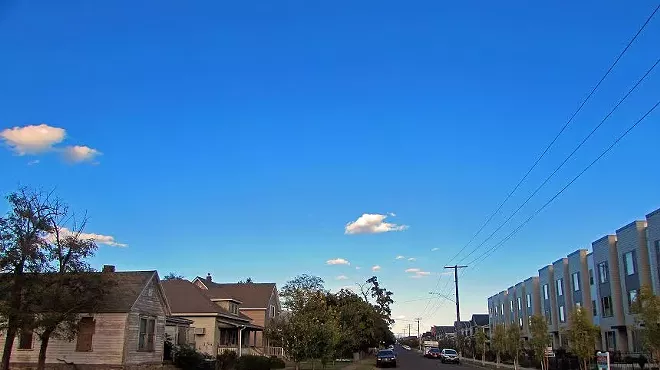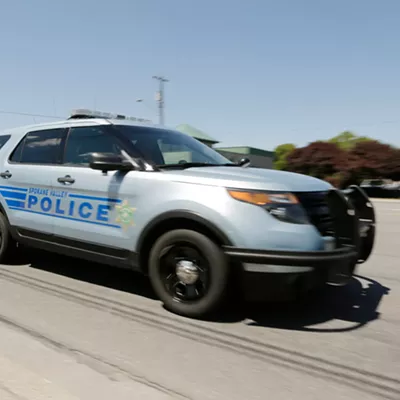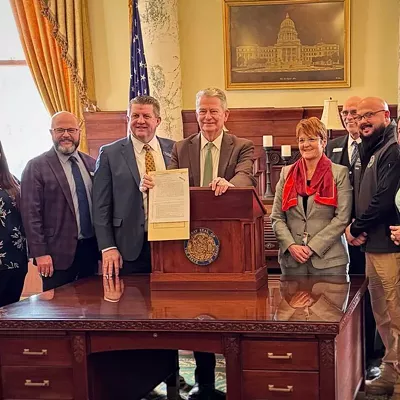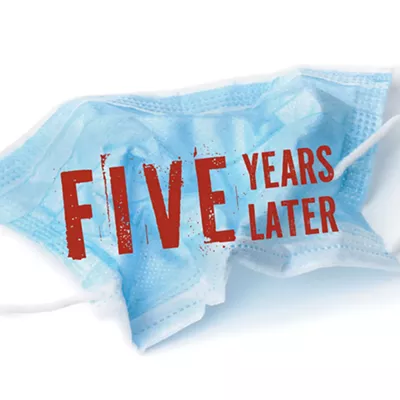
A late-night phone call rouses Carol Ellsworth as she dozes on the couch inside her Bridge Avenue home in Spokane’s West Central neighborhood. Rising to answer, she wonders who would call at such an hour and hopes against bad news.
An automated female voice sounds over the line. Authorities had found two bodies, apparent homicide victims, earlier on Dec. 7, just blocks from her home. The killers remain at large, the recorded voice warns.
“It makes you more alert,” she says in the wake of the ominous call.
A longtime resident of West Central, Ellsworth volunteers regularly at the local COPS West shop on the corner of Elm and Boone. She has worked with the Community Oriented Policing Services program for more than 20 years, watching crime come and go from behind the front counter.
Dozens of wanted posters hang in the shop’s windows. Binders of criminal codes and registered sex offender addresses line the shelves next to bright holiday ornaments and a stuffed Santa Claus teddy bear.
The West Central neighborhood offers many stark contrasts along its streets as well, with family homes falling next door to drug houses. The area struggles with above average crime rates and absentee landlords, but Ellsworth and others remain loyal to the streets they call home.
“I think the neighborhood is actually getting safer,” she says.
Hopeful residents point to new business development and increased homeownership to show the neighborhood is moving away from its troubled past. Ellsworth says she sees a slow revitalization under way.
But in a city with just a handful of murders a year, the two killings — within four blocks of each other in a single day — have brought home some of the old concerns that once plagued the area sometimes called “Felony Flats.”
AN UNWELCOME SCENE
Spokane investigators report Michelle Koenen, 48, was found strangled to death early Dec. 7 at her home on West Broadway Avenue. Police have since arrested her boyfriend in connection with the killing. The second victim, 28-year-old David “Brandon” Deponte, was later found dead from multiple gunshot wounds in a nearby alley. No suspect has been identified in his death.
Police have emphasized the two crimes do not appear to be related. Authorities also linked the deaths to involvement with illegal activities, saying law-abiding citizens have little to fear from such criminal-on-criminal violence.
“It shouldn’t be anything for people living in West Central to be concerned about their own safety,” Spokane Police Lt. Joe Walker told KXLY. “If you’re not a crook and you’re not dating a crook, you’re good to go.”
West Central Neighborhood Council President Kelly Cruz says he woke up that day to find a crime scene outside his front door. His block was cordoned off with yellow police tape. Squad cars filled the street.
“I came out of my house that morning to head off to a job and I was greeted by police,” he says.
Cruz says murders remain rare in West Central, but it’s not the first time he has encountered such a scene. He says he can recall at least a half-dozen homicides within six blocks of his home over the past three years.
“It hasn’t occurred that much,” he says. “[But] it’s strange to have two on one day within blocks of each other.”
With no killer in custody for the shooting death, Cruz acknowledges many in the neighborhood may be somewhat fearful. Residents have long struggled with recurrent crime and frustrations over community trust, but he says they have made progress on many of the area’s social issues. They have invested in community infrastructure and created an action plan to guide future development efforts.
“I’m a lifelong resident,” he says. “I feel safe walking the streets after dark. It’s not gotten that bad where you have to worry about skirting a block or something like that.”
FEELING A CHANGE
The neighborhood action plan, released this past May, outlines many of the social challenges dogging the West Central area. With more than 8,700 people living within 2.34 square miles, the neighborhood lags behind in education, income and homeownership.
“In 2010, it is estimated that the median household income for families in the West Central neighborhood is $16,257, compared with the Spokane average median income of $34,788,” the report states. “This economic disparity led to 84.4 percent of the students at one of the elementary schools which serve West Central to qualify for free or reduced price meals.”
Cruz says more than 50 social and human service agencies have centers in the West Central neighborhood. Access to those services, along with the courthouse and county jail, keeps many people with legal or financial problems within walking distance.
“If we did track the people coming out of the jail, I’d bet you at least 20, 25 percent of them live in this neighborhood,” he says. “That’s just a fact because they don’t have a car, they don’t have registration. … There’s no [other] support network for them.”
But driving along the west end of the neighborhood, Cruz points to progress. He singles out several homes with new paint and siding. A few new businesses plan to renovate and reopen historic buildings.
Cruz says he hopes to rally support for new social programs to target youth suicide, substance abuse and domestic violence. He also hopes to build a daycare program and other support services to help the neighborhood move away from its old “Felony Flats” reputation.
“That has to do with the high crime rate and drug abuse and stuff in the ’70s, ’80s and even in the early ’90s,” he says. “That’s cleaned up quite a bit. We have tried to [shed] that moniker because that’s not representative of the neighborhood really, especially in the last few years.”
Cruz turns north up Elm Street. New homes and modern apartment buildings line the streets of the new Greenstone housing development in Kendall Yards. With new investments and an influx of middle-class residents, many hope the development will help shift the neighborhood’s momentum in a positive direction.
“I feel it’s changing,” he says.
NEW COMMUNITY
Just south of Bridge Avenue, across the street from what is traditionally considered the West Central neighborhood, the long-awaited development of Kendall Yards has drawn new attention and investment to the area. Dozens of families have moved into the Greenstone homes overlooking the Spokane River while construction continues on several new businesses.
Piper Peterson moved into a Greenstone home in October 2010, making her one of the development’s pioneer residents. One of her first priorities, she says, was organizing a block watch to keep neighbors connected and share safety information.
“Right now we’re a little more isolated,” she admits. “[But] it’s a very, very friendly neighborhood, and people watch out for each other.”
Peterson lives right on Bridge Avenue, still within blocks of the recent killings. She says she is well aware of a criminal “element” in the neighborhood, but she argues the area faces the same issues as many others.
“I feel as safe in Kendall Yards as I did when I lived across the river in Browne’s Addition,” she says.
Jim Campasino, sales manager at Kendall Yards, says the Greenstone neighborhood continues to grow. He moved in three weeks ago and sees more people looking to call the area home. No one has even mentioned the recent homicides to him.
“Our sales have outpaced our ability to build,” he says.
Optimistic about the future of the neighborhood, Peterson says she has seen the recent killings as a tragic reminder of the need for community cooperation and vigilance. More residents need to get involved. They need to keep an eye on suspicious cars and notify neighbors of potential dangers.
“It just makes us more aware that safety is important,” she says. “It brings us closer together.”


















